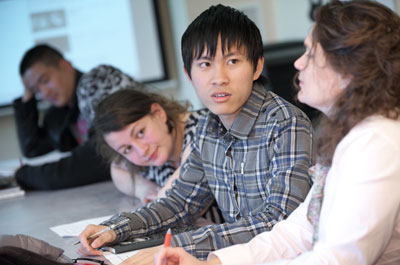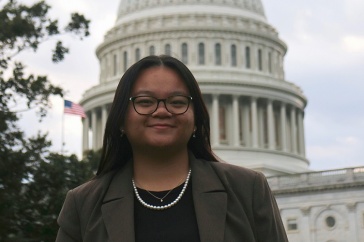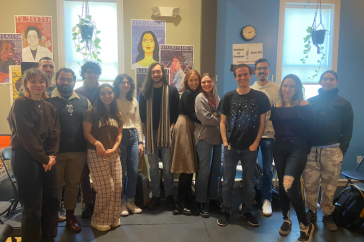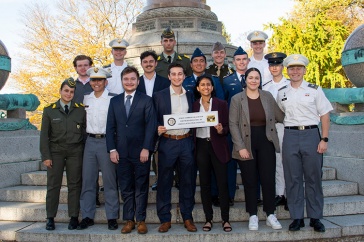|
Amal Alzahrani of Saudi Arabia and Shahriar Beigi of Iran work on a lesson together. |
Crash Course in Culture
If you grew up in the dominant culture in the U.S., you might wear shorts during the dog days of summer. But if you grew up in certain parts of the Arabian peninsula, you might never show your legs, no matter how hot it gets. That's because for some conservative Muslims, showing your legs is considered immodest—it's a cultural practice based in religious beliefs.
In the U.S., good manners might dictate that you finish the food on your plate when you're a dinner guest. However, in China, you might leave food on your plate at the end of a meal, signaling that you are satisfied. If you don't, you risk offending your host.
So what happens when you are an international student living in the U.S. for the first time? How do you understand not only the practices, but also the beliefs and assumptions surrounding those practices? How do decide which behaviors to adopt and which to avoid?
While acclimating to their studies, many international students must also acclimate to a very foreign American culture. International student enrollment at UNH is growing rapidly, fueled in large part by the new Navitas pathways program. Navitas recruits international students to UNH for an English language and core curriculum bridge to bachelor's program admission. The expansion presents opportunities and challenges for UNH logistically and academically. It also necessitates a highly effective cultural crash-course. Students have only three or four semesters to refine their language skills, learn the subject-specific language of academic disciplines, and understand the cultural expectations of a foreign country.
A Program Flourishes
The English as a Second Language (ESL) program has been in operation at UNH for decades. Mary Clark, professor of linguistics, has been working in the program for 34 years, directing it during much of that time. Originally a summer program, the ESL Institute became a small year-round program over a decade ago, serving 30-40 people per term from all over the world—very often students, sometimes businessmen, occasionally people from the surrounding communities.
With the advent of Navitas, ESL course enrollees now top 100, says Clark. By the fall of 2012, that number will double. By 2014, quadruple. In fact, the plan is to enroll 500 students through Navitas by 2015.
The rapid rate of expansion is creating its share of growing pains. Clark and her staff are in the process of hiring seven new faculty members, bringing the total number of ESL lecturers to 13 in the fall. She expects that UNH will need as many as 27 lecturers if the target number of 500 students is met. At a campus pressed for space and resources, those faculty members will need offices and access to UNH services and facilities. They will also need classrooms in which to teach, as many as ten dedicated classrooms by 2015.
Nonetheless, Clark finds the growth exciting. "It is very interesting to figure out just how to do this," Clark says. "If it works well, it is a big benefit to the University in many ways: it makes us far more international, it gives all of our students international connections that they wouldn't otherwise have. The world is a small place and it is very important to be aware of that. And, of course, financially it will be a big boon to the University."
Clark acknowledges that there is some disagreement on campus about the wisdom of the Navitas program. But given that the University has decided to undertake the initiative, Clark says, "I don't even think about whether this is a good idea, I just try morning, noon, and night to think, how can we do this very well and make this as successful as possible."
|
Jing Xuan Yang of China confers with Laura Qualliontine while Helena Gharios of Lebanon looks on. |
Teaching Culture
Laura Qualliotine is a UNH lecturer and a staff member in the ESL program. In any one class, she might have students from a half dozen or more countries, ranging from Peru to China. The strategies for teaching culture to a diverse group of students are many.
"At the most basic level, the class itself holds many values of the U.S. educational system," says Qualliotine. "Some students arrive at UNH and are surprised to find that they are expected to work in pairs and small groups in the classroom, and the teacher expects to hear students' personal opinions on a variety of topics."
The courses are also purposely intensive. Students meet five days per week for two to four hours a day, depending on a student's English language skills. This immersion creates a sense of community among the students, fosters trust, and allows time for students to learn from one another. The diversity in the classroom only adds to the sense of community.
"In a classroom comprised of students from different countries and even different regions of the same country, discussions about culture become a natural extension of every topic covered in the course," says Qualliotine.
A volunteer program called the Conversation Partner Program helps expose international students to U.S. culture outside the classroom. Full-time UNH students are matched with international students for informal weekly meetings during which language skills are practiced. However, the conversations quite often turn into friendships that pull international students into a circle of activity and relationships that give them direct experience in a variety of cultural settings.
In large part, the knowledge of culture comes with the comfort to ask questions and explore assumptions, and the courage to interact outside one's own cultural group. All practices Qualliotine encourages every day in the classroom.
"Culture is not always about rules," says Qualliotine. "It's about understanding the way people may interpret what you do. By understanding the deeper assumptions held in cultural groups, it makes the whole process more interesting and less frightening. It gives international students the power to determine whether or not they want to change their behavior to fit into a particular group."
More is More
With growing numbers of international students on campus, there is now more opportunity for American students to learn about culture, too, and not only about the many foreign cultures represented here. Interactions might also prompt students to look with fresh eyes at their own cultural practices and assumptions, providing insight into their choices and behaviors. That type of education can extend to UNH faculty, staff, and the wider community, as well.
Originally published by:
The College Letter, Newsletter for the College of Liberal Arts
-
Written By:
Susan Dumais '88 '02G | College of Liberal Arts



















































